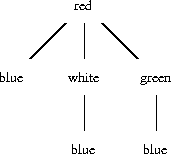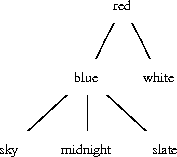red * blue matches
the paths red white blue and red green blue in the tree

The Problem
Write a program that reads a tree description and some path patterns from std-in and writes to std-out all paths in the tree that match the path patterns.Input
All input comes from std-in. Input is in two parts: a description of a tree and sequence of zero or more path patterns. The two parts are separated by one or more blank lines, which is a line containing only space characters.The tree description is input one node label per line. The labels of the child nodes are indented relative to the label of the parent node; all child labels of the same parent have the same indentation. For example, the input
red
blue
sky
midnight
slate
white

Each path pattern is input one per line; each line contains at most one path pattern. Path patterns have the format described above; white space in a path pattern is ignored.
Output
The paths matching a given path pattern should be written to std-out one path per line. Paths should be output in the same order as the path patterns that were input. The paths between successive input path patterns should be separated by at least one blank line. If no paths match a pattern,[none]
should be output.
The program should print an informative error message when it detects an error
in the tree description and end execution without further processing. If the
program detects an error in a path pattern, it should print an informative
error message and go on to the next path pattern, if any. As always, error
messages should be written to std-err and start with a bang-space ("!
").
Testing
You can usegen-input, available in the class assignment directory
/export/home/class/cs-503/a4, to generate input for your program. When run, it writes
an randomly generated tree description to std-out, followed by some
randomly generated path expressions. You can use it with your program like so:
Because$ ./gen-input | ./tree-search
gen-input creates new input each time it's run, you might find it
more convenient to save the input in a file to provide your program with
consistent input:
My solution$ ./gen-input > input $ ./search-tree < input
match-paths is also available in the class assignment
directory. Remember the purpose of this assignment is to implement a correct
solution, not to copy the behavior of my solution. If my solution's wrong and
you copy the incorrect behavior, you're going to lose points.
| This page last modified on 22 March 2006. |